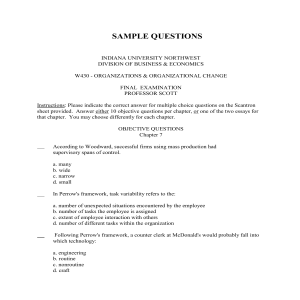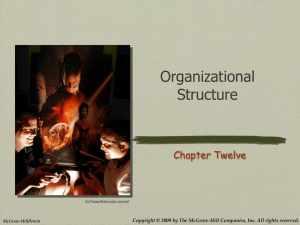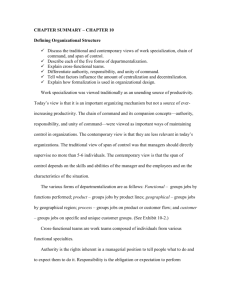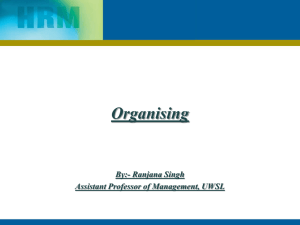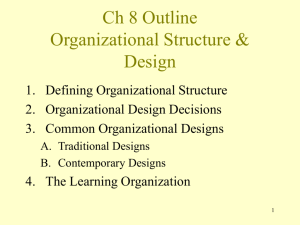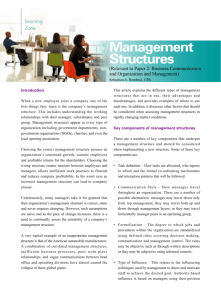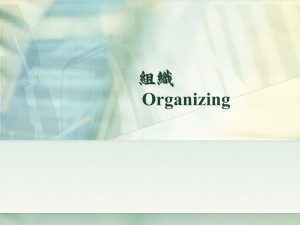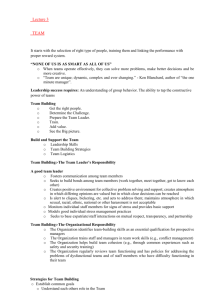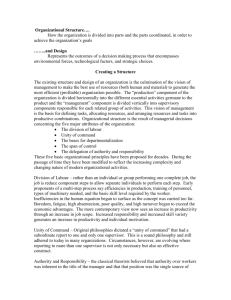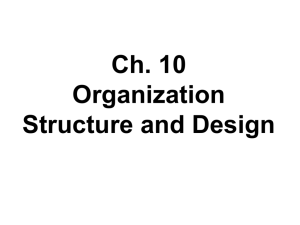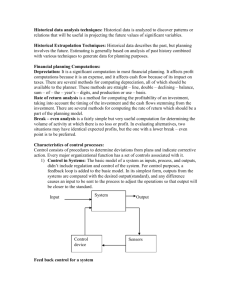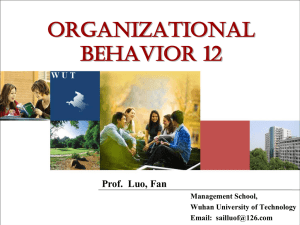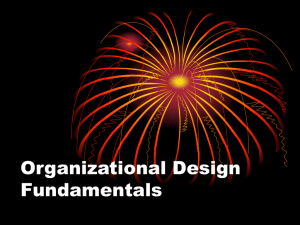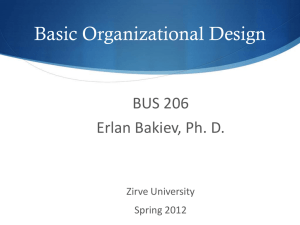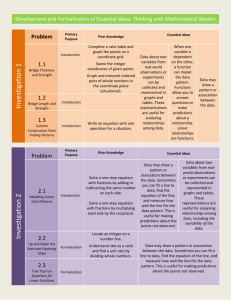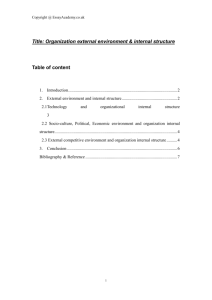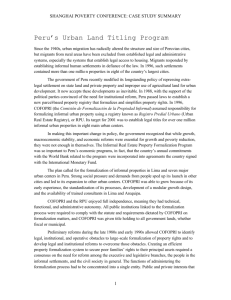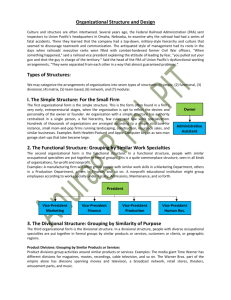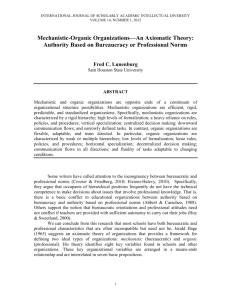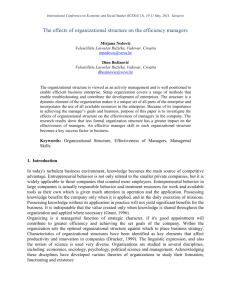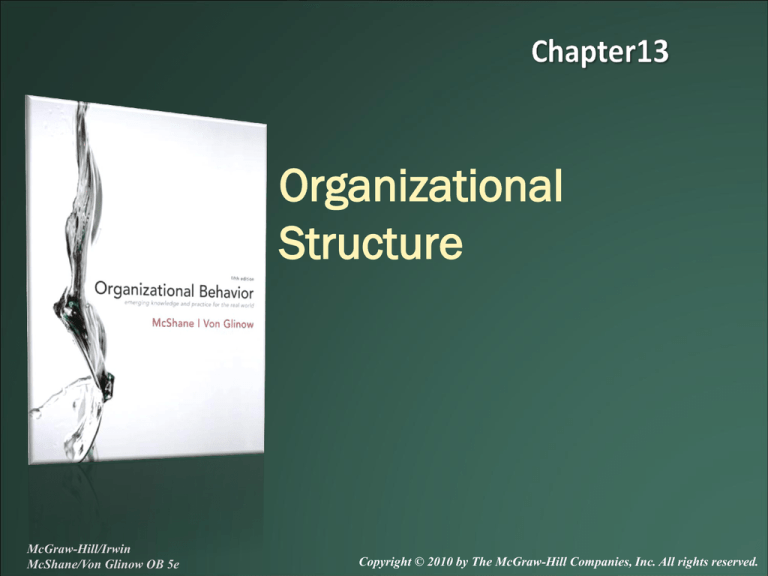
Organizational
Structure
McGraw-Hill/Irwin
McShane/Von Glinow OB 5e
Copyright © 2010 by The McGraw-Hill Companies, Inc. All rights reserved.
Choosing an Organizational Structure
at BioWare
Ray Muzyka (left) and Greg
Zeschuk (right) designed an
organizational structure for
their electronic games
company, Bioware, that
balances the need for
teamwork and information
sharing.
13-2
Organizational Structure Defined
Division of labor and patterns of
coordination, communication,
workflow, and formal power that
direct organizational activities.
Relates to many OB topics
• e.g. job design, teams, power,
org culture, org change
13-3
Division of Labor
Subdividing work into separate
jobs assigned to different
people
Division of labor is limited by
ability to coordinate work
Potentially increases work
efficiency
Necessary as company grows
and work becomes more
complex
13-4
Coordinating Work Activities
Informal communication
1.
• Sharing information, forming common mental
•
•
•
•
•
models
Allows flexibility
Vital in nonroutine and ambiguous situations
Easiest in small firms
Applied in team-based structures
Includes integrator roles
13-5
Coordinating Work Activities
2.
Formal hierarchy
• Direct supervision
• Assigns formal (legitimate) power to manage
others
• Coordination strategy for departmentalization
3.
Standardization
a) Standardized processes (e.g., job descriptions)
b) Standardized outputs (e.g., sales targets)
c) Standardized skills (e.g., training)
13-6
Elements of Organizational Structure
Departmentalization
Span of
Control
Elements of
Organizational
Structure
Formalization
Centralization
13-7
Span of Control
Number of people directly
reporting to the next level
• Assumes coordination through
direct supervision
Wider span of control possible
when:
• Other coordinating
mechanisms present
• Routine tasks
• Low employee
interdependence
13-8
Tall vs Flat Structures
As companies grow, they:
• Build taller hierarchy
• Widen span, or both
Problems with tall hierarchies
• Overhead costs
• Worse upward information
• Focus power around managers,
so staff less empowered
13-9
Issues with Tall vs Flatter Structures
Firms moving toward flatter structures
(delayering) because taller hierarchies have:
• Higher mgt overhead costs
• Less information flow
• Less staff empowerment
But also problems with flatter hierarchies
• Undermines management functions
• Increases workload and stress
• Restricts management career development
13-10
Centralization and Decentralization
Centralization
Formal decision making authority is held
by a few people, usually at the top
Decision making authority is
dispersed throughout the organization
Decentralization
13-11
Formalization
The degree to which organizations standardize
behavior through rules, procedures, formal training,
and related mechanisms.
Formalization increases as firms get older, larger,
and more regulated
Problems with formalization
• Reduces organizational flexibility
• Discourages organizational learning/creativity
• Reduces work efficiency
• Increases job dissatisfaction and work stress
13-12
Growing an Organic Taxi
Award-winning TAXI relies on an
organic structure to maintain its
creative advantage. TAXI cofounder
Paul Lavoie (bottom right in this
New York City office photo) says
that most firms are “so layered that
a great idea was easily
crushed…We needed a flexible
infrastructure, able to move with the
pace of change. TAXI started lean
and nimble, and remains so today.”
13-13
Mechanistic vs. Organic Structures
Organic Structure
• Wide span of control
• Little formalization
• Decentralized decisions
Mechanistic Structure
• Narrow span of control
• High formalization
• High centralization
13-14
Departmentalization
Specifies how employees and their activities
are grouped together
Three functions of departmentalization
1. Establishes chain of command
2. Creates common mental models, measures of
performance, etc
3. Encourages coordination through informal
communication
13-15
Functional Organizational Structure
Organizes employees around specific knowledge
or other resources (e.g., marketing, production)
CEO
Finance
Production
Marketing
13-16
Evaluating Functional Structures
Benefits
• Economy of scale
• Supports professional identity and career paths
• Easier supervision
Limitations
• More emphasis on subunit than organizational
goals
• Higher dysfunctional conflict
• Poorer coordination -- requires more controls
13-17
Divisional Structure
Organizes employees around outputs,
clients, or geographic areas
CEO
Healthcare
Lighting
Products
Consumer
Lifestyle
13-18
Divisional Structure
Different forms of divisional structure
• Geographic structure
• Product structure
• Client structure
Best form depends on environmental diversity
or uncertainty
Movement away from geographic form
• Less need for local representation
• Reduced geographic variation
• More global clients
13-19
Evaluating Divisional Structures
Benefits
• Building block structure -- accommodates growth
• Focuses on markets/products/clients
Limitations
• Duplication, inefficient use of resources
• Specializations are dispersed--silos of knowledge
• Politics/conflict when two forms of equal value
13-20
Team-Based Structure
Self-directed work teams
Teams organized around work processes
Typically organic structure
• Wide span of control – many employees work
without close supervision
• Decentralized with moderate/little formalization
Usually found within divisionalized structure
13-21
Evaluating Team-Based Structures
Benefits
• Responsive, flexible
• Lower admin costs
• Quicker, more informed decisions
Limitations
•
•
•
•
•
Interpersonal training costs
Slower during team development
Role ambiguity increases stress
Problems with supervisor role changes
Duplication of resources
13-22
Bioware’s Matrix Structure
Ray Muzyka (left) and Greg
Zeschuk (right) adopted a
matrix organizational
structure for their electronic
games company, Bioware,
because it balances the need
for teamwork and information
sharing.
13-23
Matrix Structure (Project-based)
Employees ( ) are temporarily assigned to a specific
project team and have a permanent functional unit
CEO
Game1
Project Leader
Game2
Project Leader
Game3
Project Leader
Art Dept
Leader
Software
Dept Leader
Audio Dept
Leader
13-24
Evaluating Matrix Structures
Benefits
•
•
•
•
•
Uses resources and expertise effectively
Improves communication, flexibility, innovation
Focuses specialists on clients and products
Supports knowledge sharing within specialty
Solution when two divisions have equal importance
Limitations
• Increases goal conflict and ambiguity
• Two bosses dilutes accountability
• More conflict, organizational politics, and stress
13-25
Network Organizational Structure
Alliance of firms
creating a product or
service
Supporting firms
beehived around a
“hub” or “core” firm
Product
development
partner
(U.S.A.)
Callcenter
partner
(Philippines)
Core
Firm
Package
design
partner
(UK)
Accounting
partner
(U.S.A.)
Assembly
partner
(Mexico)
13-26
Evaluating Network Structures
Benefits
• Highly flexible
• Potentially better use of skills and technology
• Not saddled with same resources for all products
Limitations
• Exposed to market forces
• Less control over subcontractors than in-house
13-27
External Environment & Structure
Dynamic
• High rate of change
• Use team-based, network, or
other organic structure
Complex
• Many elements (such as
stakeholders)
• Decentralize
Stable
• Steady conditions,
predictable change
• Use mechanistic structure
Simple
• Few environmental elements
• Less need to decentralize
13-28
External Environment & Structure (con’t)
Diverse
• Several products, clients,
regions
• Use divisional form aligned
with the diversity
Hostile
• Competition and resource
scarcity
• Use organic structure for
responsiveness
Integrated
• Single product, client, place
• Use functional structure, or
geographic division if global
Munificent
• Plenty of resources and
product demand
• Less need for organic
structure
13-29
Effects of Organizational Size
As organizations grow, they have:
More division of labor (job specialization)
Greater use of standardization
More hierarchy and formalization
More decentralization
13-30
Technology and Structure
Technology refers to mechanisms or
processes by which an organization turns out
its product or service
Two contingencies:
• Variability -- the number of exceptions to standard
procedure that tend to occur.
• Analyzability -- the predictability or difficulty of the
required work
13-31
Organizational Strategy
Structure follows strategy
• Strategy points to the environments in which the
organization will operate
• Leaders decide which structure to apply
Differentiation strategy
• Providing unique products or attracting clients who
want customization
Cost leadership strategy
• Maximize productivity in order to offer competitive
pricing
13-32
Organizational
Structure
McGraw-Hill/Irwin
McShane/Von Glinow OB 5e
Copyright © 2010 by The McGraw-Hill Companies, Inc. All rights reserved.
13-33


